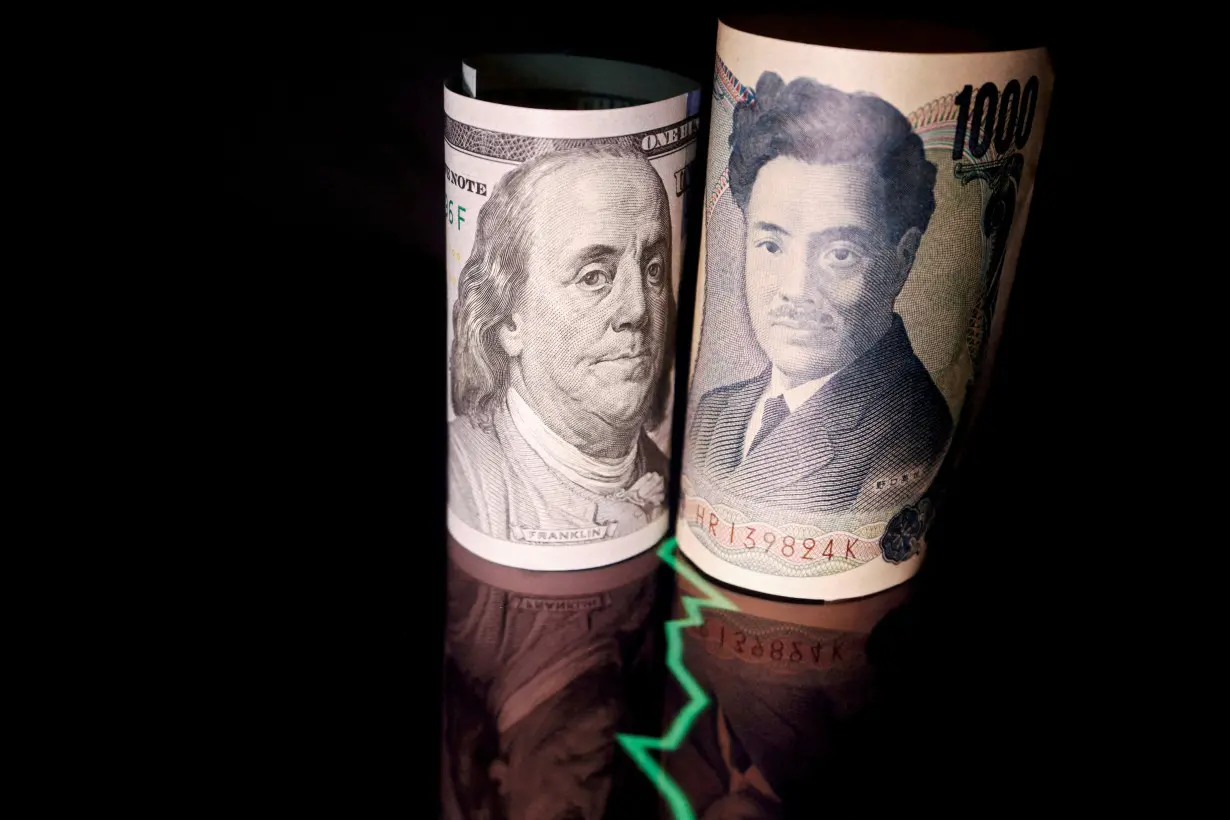By Gertrude Chavez-Dreyfuss
NEW YORK (Reuters) -The yen dropped to multi-year lows against the U.S. dollar and euro on Tuesday, keeping investors on heightened Japanese intervention watch ahead of this week's Bank of Japan policy meeting.
The euro reached 165.71 yen, its highest since 2008, after data showed business activity in the euro zone expanded at its fastest pace in nearly a year, primarily due to a recovery in services. Europe's common currency was last up 0.4% at 165.67 yen .
The dollar rose as high as 154.88 against the yen , a 34-year peak and edging closer to 155, a level seen by market participants as the new trigger for Japanese intervention.
The greenback was last little changed on the day at 154.79 yen.
"The 155 level for dollar/yen is a key psychological figure after Japanese officials neglected to step in on behalf of their currency at 152," said Helen Given, FX trader at Monex USA in Washington.
"Though (BOJ Governor Kazuo) Ueda has said multiple times that the BoJ will not hike interest rates solely to boost the yen, there is a lot of potential for action from currency officials in tandem with Friday's meeting."
She added that the BOJ is likely to stand pat on Friday, which could mean further yen weakness, but thinks "there is a fairly good chance that we see market intervention that same night to prevent a bigger slide toward 160."
Earlier on Tuesday, Japanese Finance Minister Shunichi Suzuki gave his strongest warning yet on the chance of intervention, saying last week's meeting with his U.S. and South Korean counterparts laid the groundwork for Tokyo to act against excessive yen moves.
However, there were doubts whether Tokyo would act so close to the BOJ's two-day policy meeting that starts on Thursday.
Japan's central bank is expected to forecast that inflation will stay around its 2% target for the next three years in a new estimate due on Friday, signalling its readiness to cautiously raise interest rates again this year from near-zero levels.
The dollar did inch lower against the yen after data showed U.S. business activity eased in April to a four-month low amid weaker demand.
S&P Global said on Tuesday its flash U.S. Composite PMI Output Index, which tracks both the manufacturing and services sectors, fell to 50.9, a level slightly above expansion territory, from 52.1 in March.
The dollar index also dropped after the PMI data, down 0.4% at 105.66. It fell to a two-week low of 105.61.
The euro, meanwhile, climbed to a two-week peak against the dollar of $1.0711, before drifting back to trade at $1.0707, up 0.5%.
The common currency also briefly matched the previous day's three-month high against the pound of 86.43 pence, after the German PMI data. The euro was last down 0.3% at 85.95 pence .
Dovish policymaker comments from the Bank of England left sterling near its weakest in months. BOE officials said they expect inflation to slow back towards the 2% target, and likely stay there, which gave investors confidence in their belief that the bank will cut rates in the summer.
Earlier in the year, the pound was lifted by expectations that the BoE would cut rates meaningfully later than the European Central Bank, which markets currently see easing in June.
The British currency had fallen to a five-month low of $1.2299 against the dollar on Monday, but recovered on Tuesday to $1.2450, up 0.8% in the wake of strong British business activity data.
In the United States, investors expect the Federal Reserve to be one of the last major central banks to cut, with the rate futures market currently pricing in a 73% chance of its first easing by September, according to the CME's FedWatch tool.
That was in sharp contrast to a few weeks ago when markets were betting on June for the Fed easing cycle to begin, a shift that has driven the dollar higher.
Investors will have another chance to assess the strength of the U.S. economy this week with first-quarter gross domestic product data on Thursday and personal consumption price expenditures (PCE) index, the Fed's preferred measure of inflation, on Friday.
Market players anticipate a 0.3% increase in the headline PCE number in March, unchanged from the previous month, and a year-on-year gain of 2.6%, compared with a 2.5% increase in February, according to a Reuters poll.
(Reporting by Gertrude Chavez-Dreyfuss; Additional reporting by Alun John in London and Brigid Riley in Tokyo; Editing by Shri Navaratnam, William Maclean, Alexander Smith, Alex Richardson and Mark Heinrich)

 Why AP called Arizona for Trump
Why AP called Arizona for Trump
 Trump wins Arizona, sweeping all seven battleground states, Edison Research says
Trump wins Arizona, sweeping all seven battleground states, Edison Research says
 China, Indonesia enhance ties with key deals on lithium, green energy, tourism
China, Indonesia enhance ties with key deals on lithium, green energy, tourism
 King Charles III and Kate will attend remembrance events as both royals slowly return to duty
King Charles III and Kate will attend remembrance events as both royals slowly return to duty
 Taliban administration officials to attend UN climate conference in Azerbaijan
Taliban administration officials to attend UN climate conference in Azerbaijan
 Trump has vowed to kill US offshore wind projects. Will he succeed?
Trump has vowed to kill US offshore wind projects. Will he succeed?
 US to speed up interceptor missiles delivery to Ukraine, WSJ reports
US to speed up interceptor missiles delivery to Ukraine, WSJ reports
 Jalen Milroe runs for career-high 185 yards and 4 TDs as No. 11 Alabama thrashes No. 14 LSU 42-13
Jalen Milroe runs for career-high 185 yards and 4 TDs as No. 11 Alabama thrashes No. 14 LSU 42-13
 Justin Allgaier wins 1st NASCAR Xfinity title, capping comeback by passing Hill and Custer late
Justin Allgaier wins 1st NASCAR Xfinity title, capping comeback by passing Hill and Custer late
 Evan Mobley scores 23 points and Cavaliers rally past Nets 105-100 to remain perfect at 11-0
Evan Mobley scores 23 points and Cavaliers rally past Nets 105-100 to remain perfect at 11-0

